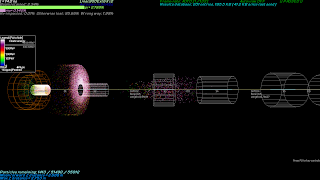At long last, Muon1 has a client update. Version 4.45 went live 2 weeks ago, and carries some significant upgrades. Along with a better, more stable graphical mode, it's accuracy has also been significantly improved.
Muon1 is an odd project in many ways. Run entirely by one man over the last 10 years, (first in his spare time, and then as one aspect of his job as "accelerator physicist", part-funded by the UK neutrino factory), it has a shoestring budget, and limited help from the Rutherford Appleton Laboratory and yet is really pushing the boundaries of both physics and computing. For the last 3 years, v4.44d has been the mainstay of the project, but now v4.45 is out and has a host of new and improved features.
The first, and most obvious change, is to the graphical engine. After many years of using DirectDraw, it's now using OpenGL, which also means greater compatibility with non-windows systems using emulators. There are also a number of other benefits too. For a start, it now means that it's using a true colour pallete instead of an 8-bit one, meaning that screen-shots no longer need colour-correction, but are a simple 'Prt Scr' away. Particles are now drawn as icons as well, which aids identification for the science-buffs out there. As you can see, the results are quite lovely
 |
| A look down the accelerator in the fully controllable visual mode click to enlarge |
 |
| 'Failed' (impacted) particles impacted on the left, as the cloud of viable particles moves on click to enlarge |
 |
| Problem areas in the design can be easily identified click to enlarge |
There is also the new option of a 'span' mode, if, like me, you have multiple monitors. It looks nice as it takes up the entire screen, although at present it seems to stretch itself from one to two screens, displaying the same 'area' in an elongated way, rather than actually using the additional width, but it's early days yet.
 |
| In wide-screen "span" mode. Higher energy 'red' particles are overtaking lower energy (slower) 'green' ones click to enlarge |
The most important change by far though, is in it's accuracy.
Previous versions have had a slight problem with 'flutter' or noise, meaning results are not always the most accurate. In September/October 2010, a group of users ran a detailed scan, testing a set design with only a single variable changed throughout. It used the (recently discontinued) Linac900Ext10d2 lattice, and changed only one variable, “ls5l” in its full range from 000 to 999. Under v4.44d, it gave the following graph. (red dots are runs that were done 5 times, as they were 'best' runs, and their score averaged)
 |
| v4.44d click to enlarge. Credit: SJ Brooks |
 |
| v4.45 versus v4.44d click to enlarge. Credit: SJ Brooks |
There is no doubt though, that Muon1 leads the field in 2nd-generation, massive-scale distributed computing. Not only is it one of the few genetic-based projects, it's also one run on almost no resources, while still being not just cutting edge, but bleeding edge. That's something not only remarkable, but uniquely British too.
If you want to participate, visit http://stephenbrooks.org/muon1/
You can also follow it on facebook, which includes weekly updates of results, and other announcements.
Graphs are by Stephen Brooks, released to the public domain.


No comments:
Post a Comment